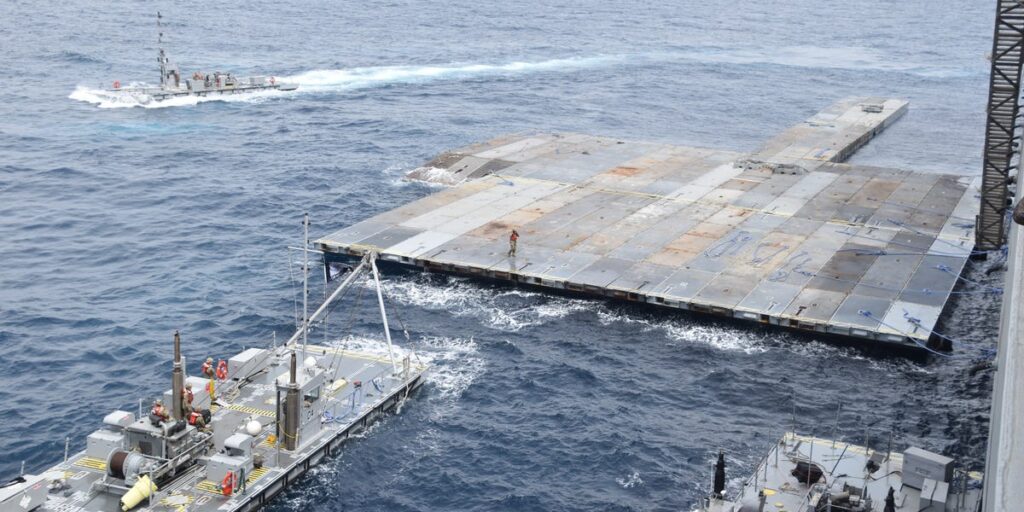The Pentagon said Tuesday that US soldiers had been stuck on three Army boats beached in Gaza over the weekend after high seas and a storm broke apart an aid pier the service built to deliver food to starving Palestinians.
US Central Command confirmed that the soldiers had been evacuated from the boats by Tuesday after the vessels broke free from their moorings on Saturday, though it was not immediately clear how long the troops were stuck on the shore. The update immediately followed earlier information released by the Pentagon that the soldiers were still aboard the grounded boats.
Along with the beachings of the Army boats, the storm also battered and broke apart the aid pier — a Joint Logistics Over-the-Shore, or JLOTS, operation by the Army — leaving the future of the key US humanitarian effort uncertain. The pier was set up to move hundreds of metric tons of aid to the area amid a brutal, months-long Israeli offensive against Hamas.
The boat groundings and destruction are the latest trouble for the pier and could disrupt the US effort for at least a week, according to the Pentagon.
“The Israeli navy will be helping push those vessels back, and hopefully they’ll be fully operational,” Pentagon spokeswoman Sabrina Singh said Tuesday, noting that one ship should be recovered in the next day and the other two in the next 48 hours.
Minutes after the briefing concluded, a defense official told Military.com that “all service members have been removed from the beached vessels.”
In addition to the storms beaching the four boats that were holding the aid pier in place, Singh confirmed that “a portion of the Trident pier separated from the pier that is currently anchored into the coast of Gaza” and “the Trident pier was damaged.”
Video of the section of pier, broken off and floating in the water, was posted to social media Monday.
Singh said the broken section was eventually recovered and that the pier will be completely removed from its location in Gaza in the next 48 hours to be towed back to the Israeli port of Ashdod for repairs.
Rebuilding and repairs will take “at least over a week,” according to Singh.
The Pentagon spokeswoman said that the military’s intention is to repair and eventually re-anchor the temporary pier to the coast and “resume humanitarian aid to the people who need it most.”
Singh said that the dramatic halt to the aid mission and beaching of the ships were the result of a “unique, unfortunate pattern of events with high seas and another storm that came in” and rendered the pier inoperable.
However, this is also not the first hurdle that the aid mission has encountered since it was announced by President Joe Biden during his State of the Union speech months ago.
In April, one of the ships set to carry supplies for the mission was forced to turn back to port after experiencing a fire in its engine room. Ship trackers and maritime experts also noted that one of the Army ships seemed to get stuck in Tenerife — a small island that is part of the Canary Islands cluster off the west coast of Africa — leading to speculation and concerns about more breakdowns.
In late April, a mortar attack hit the shoreline near the pier’s eventual location but caused “minimal damage.” Then, as troops readied the pier for installation, high seas caused delays.
Even once the pier was up and running, snags and problems continued to crop up.
Last week, Pentagon officials conceded that some of the first truckloads of aid were not making it to the Palestinians but rather into the hands of looters. Reporters also found that Israeli settlers have taken to attacking aid shipments at border crossings, and some aid groups have accused Israeli security forces of tipping off settlers to aid convoy routes — in turn, allowing them to attack or block them.
On Tuesday, Singh was adamant that, despite setbacks and problems, the mission is valuable and the Pentagon is determined to see it through.
“You have men and women out there, separated from their families … who are putting others first to try and be part of a lifesaving mission that has seen over 1,000 metric tons of aid come in,” Singh said.
“So, hopefully, when we are able to re-anchor the pier back in, you’ll be able to see that aid flow off in a pretty steady stream,” she added.
Editor’s note: This story has been updated with information from US Central Command.
Read the full article here
















